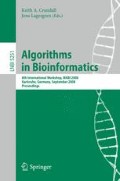Abstract
We consider a graph orientation problem arising in the study of biological networks. Given an undirected graph and a list of ordered source-target pairs, the goal is to orient the graph so that a maximum number of pairs will admit a directed path from the source to the target. We show that the problem is NP-hard and hard to approximate to within a constant ratio. We then study restrictions of the problem to various graph classes, and provide an O(logn) approximation algorithm for the general case. We show that this algorithm achieves very tight approximation ratios in practice and is able to infer edge directions with high accuracy on both simulated and real network data.
Access this chapter
Tax calculation will be finalised at checkout
Purchases are for personal use only
Preview
Unable to display preview. Download preview PDF.
References
Arkin, E.M., Hassin, R.: A note on orientations of mixed graphs. Discrete Applied Mathematics 116(3), 271–278 (2002)
Feige, U., Goemans, M.X.: Aproximating the value of two prover proof systems, with applications to MAX 2-SAT and MAX DI-CUT. In: ISTCS, pp. 182–189 (1995)
Fields, S.: High-throughput two-hybrid analysis the promise and the peril. Febs. J. 272(21), 5391–5399 (2005)
Hakimi, S.L., Schmeichel, E., Young, N.E.: Orienting graphs to optimize reachability. Information Processing Letters 63(5), 229–235 (1997)
Hassin, R., Megiddo, N.: On orientations and shortest paths. Linear Algebra and its applications 114/115, 589–602 (1989)
Håstad, J.: Some optimal inapproximability results. Journal of the ACM 48(4), 798–859 (2001)
Hochbaum, D.S.: Efficient bounds for the stable set, vertex cover and set packing problems. Discrete Applied Mathematics 6, 243–254 (1983)
Kann, V., Lagergren, J., Panconesi, A.: Approximability of maximum splitting of k-sets and some other apx-complete problems. Information Processing Letters 58(3), 105–110 (1996)
Lewin, M., Livnat, D., Zwick, U.: Improved rounding techniques for the MAX 2-SAT and MAX DI-CUT problems. In: Proceedings of the 9th International IPCO Conference on Integer Programming and Combinatorial Optimization, London, UK, pp. 67–82. Springer, Heidelberg (2002)
Ptacek, J., Devgan, G., Michaud, G., Zhu, H., Zhu, X., Fasolo, J., Guo, H., Jona, G., Breitkreutz, A., Sopko, R., McCartney, R.R., Schmidt, M.C., Rachidi, N., Lee, S.J., Mah, A.S., Meng, L., Stark, M.J., Stern, D.F., De Virgilio, C., Tyers, M., Andrews, B., Gerstein, M., Schweitzer, B., Predki, P.F., Snyder, M.: Global analysis of protein phosphorylation in yeast. Nature 438, 679–684 (2005)
Salwinski, L., Miller, C.S., Smith, A.J., Pettit, F.K., Bowie, J.U., Eisenberg, D.: The database of interacting proteins: 2004 update. Nucleic Acids Research 32, D449 (2004)
Yeang, C.-H., Ideker, T., Jaakkola, T.: Physical network models. Journal of Computational Biology 11(2/3), 243–262 (2004)
Author information
Authors and Affiliations
Editor information
Rights and permissions
Copyright information
© 2008 Springer-Verlag Berlin Heidelberg
About this paper
Cite this paper
Medvedovsky, A., Bafna, V., Zwick, U., Sharan, R. (2008). An Algorithm for Orienting Graphs Based on Cause-Effect Pairs and Its Applications to Orienting Protein Networks. In: Crandall, K.A., Lagergren, J. (eds) Algorithms in Bioinformatics. WABI 2008. Lecture Notes in Computer Science(), vol 5251. Springer, Berlin, Heidelberg. https://doi.org/10.1007/978-3-540-87361-7_19
Download citation
DOI: https://doi.org/10.1007/978-3-540-87361-7_19
Publisher Name: Springer, Berlin, Heidelberg
Print ISBN: 978-3-540-87360-0
Online ISBN: 978-3-540-87361-7
eBook Packages: Computer ScienceComputer Science (R0)

